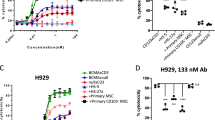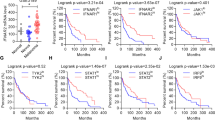Abstract
Adoptive transfer of chimeric antigen receptor (CAR)-redirected T lymphocytes (CAR-T cells) has had less striking therapeutic effects in solid tumors1,2,3 than in lymphoid malignancies4,5. Although active tumor-mediated immunosuppression may have a role in limiting the efficacy of CAR-T cells6, functional changes in T lymphocytes after their ex vivo manipulation may also account for the reduced ability of cultured CAR-T cells to penetrate stroma-rich solid tumors compared with lymphoid tissues. We therefore studied the capacity of human in vitro–cultured CAR-T cells to degrade components of the extracellular matrix (ECM). In contrast to freshly isolated T lymphocytes, we found that in vitro–cultured T lymphocytes lack expression of the enzyme heparanase (HPSE), which degrades heparan sulfate proteoglycans, the main components of ECM. We found that HPSE mRNA is downregulated in in vitro–expanded T cells, which may be a consequence of p53 (officially known as TP53, encoding tumor protein 53) binding to the HPSE gene promoter. We therefore engineered CAR-T cells to express HPSE and showed their improved capacity to degrade the ECM, which promoted tumor T cell infiltration and antitumor activity. The use of this strategy may enhance the activity of CAR-T cells in individuals with stroma-rich solid tumors.
This is a preview of subscription content, access via your institution
Access options
Subscribe to this journal
Receive 12 print issues and online access
$209.00 per year
only $17.42 per issue
Buy this article
- Purchase on Springer Link
- Instant access to full article PDF
Prices may be subject to local taxes which are calculated during checkout




Similar content being viewed by others
Accession codes
References
Pule, M.A. et al. Virus-specific T cells engineered to coexpress tumor-specific receptors: persistence and antitumor activity in individuals with neuroblastoma. Nat. Med. 14, 1264–1270 (2008).
Kershaw, M.H. et al. A phase I study on adoptive immunotherapy using gene-modified T cells for ovarian cancer. Clin. Cancer Res. 12, 6106–6115 (2006).
Bawley, V.S. et al. T cells redirected against HER2 for adoptive immunotherapy for HER2-positive osteosarcoma. Cancer Res. 72, 3500 (2012).
Kalos, M. et al. T cells with chimeric antigen receptors have potent antitumor effects and can establish memory in patients with advanced leukemia. Sci. Transl. Med. 3, 95ra73 (2011).
Brentjens, R.J. et al. CD19-targeted T cells rapidly induce molecular remissions in adults with chemotherapy-refractory acute lymphoblastic leukemia. Sci. Transl. Med. 5, 177ra38 (2013).
Zou, W. Immunosuppressive networks in the tumour environment and their therapeutic relevance. Nat. Rev. Cancer 5, 263–274 (2005).
Savoldo, B. et al. CD28 costimulation improves expansion and persistence of chimeric antigen receptor-modified T cells in lymphoma patients. J. Clin. Invest. 121, 1822–1826 (2011).
Muller, W.A. Leukocyte-endothelial-cell interactions in leukocyte transmigration and the inflammatory response. Trends Immunol. 24, 327–334 (2003).
Parish, C.R. The role of heparan sulphate in inflammation. Nat. Rev. Immunol. 6, 633–643 (2006).
Yadav, R., Larbi, K.Y., Young, R.E. & Nourshargh, S. Migration of leukocytes through the vessel wall and beyond. Thromb. Haemost. 90, 598–606 (2003).
Bernfield, M. et al. Functions of cell surface heparan sulfate proteoglycans. Annu. Rev. Biochem. 68, 729–777 (1999).
de Mestre, A.M., Staykova, M.A., Hornby, J.R., Willenborg, D.O. & Hulett, M.D. Expression of the heparan sulfate-degrading enzyme heparanase is induced in infiltrating CD4+ T cells in experimental autoimmune encephalomyelitis and regulated at the level of transcription by early growth response gene 1. J. Leukoc. Biol. 82, 1289–1300 (2007).
Vlodavsky, I., Ilan, N., Naggi, A. & Casu, B. Heparanase: structure, biological functions, and inhibition by heparin-derived mimetics of heparan sulfate. Curr. Pharm. Des. 13, 2057–2073 (2007).
Yurchenco, P.D. & Schittny, J.C. Molecular architecture of basement membranes. FASEB J. 4, 1577–1590 (1990).
Fridman, R. et al. Soluble antigen induces T lymphocytes to secrete an endoglycosidase that degrades the heparan sulfate moiety of subendothelial extracellular matrix. J. Cell. Physiol. 130, 85–92 (1987).
Naparstek, Y., Cohen, I.R., Fuks, Z. & Vlodavsky, I. Activated T lymphocytes produce a matrix-degrading heparan sulphate endoglycosidase. Nature 310, 241–244 (1984).
Vlodavsky, I. et al. Expression of heparanase by platelets and circulating cells of the immune system: possible involvement in diapedesis and extravasation. Invasion Metastasis 12, 112–127 (1992).
Bartlett, M.R., Underwood, P.A. & Parish, C.R. Comparative analysis of the ability of leucocytes, endothelial cells and platelets to degrade the subendothelial basement membrane: evidence for cytokine dependence and detection of a novel sulfatase. Immunol. Cell Biol. 73, 113–124 (1995).
Smith, C.A. et al. Production of genetically modified Epstein-Barr virus-specific cytotoxic T cells for adoptive transfer to patients at high risk of EBV-associated lymphoproliferative disease. J. Hematother. 4, 73–79 (1995).
Baraz, L., Haupt, Y., Elkin, M., Peretz, T. & Vlodavsky, I. Tumor suppressor p53 regulates heparanase gene expression. Oncogene 25, 3939–3947 (2006).
Mondal, A.M. et al. p53 isoforms regulate aging- and tumor-associated replicative senescence in T lymphocytes. J. Clin. Invest. 123, 5247–5257 (2013).
Gallagher, J.T. Heparan sulfate: growth control with a restricted sequence menu. J. Clin. Invest. 108, 357–361 (2001).
Iozzo, R.V. Matrix proteoglycans: from molecular design to cellular function. Annu. Rev. Biochem. 67, 609–652 (1998).
Nakajima, M., Irimura, T., Di, F.N. & Nicolson, G.L. Metastatic melanoma cell heparanase. Characterization of heparan sulfate degradation fragments produced by B16 melanoma endoglucuronidase. J. Biol. Chem. 259, 2283–2290 (1984).
Craddock, J.A. et al. Enhanced tumor trafficking of GD2 chimeric antigen receptor T cells by expression of the chemokine receptor CCR2b. J. Immunother. 33, 780–788 (2010).
Patterson, D.M., Shohet, J.M. & Kim, E.S. Preclinical models of pediatric solid tumors (neuroblastoma) and their use in drug discovery. Curr. Protoc. Pharmacol. 52, 14.17.1–14.17.18 (2011).
Geldres, C. et al. T lymphocytes redirected against the chondroitin sulfate proteoglycan-4 control the growth of multiple solid tumors both in vitro and in vivo. Clin. Cancer Res. 20, 962–971 (2014).
Arvatz, G., Barash, U., Nativ, O., Ilan, N. & Vlodavsky, I. Post-transcriptional regulation of heparanase gene expression by a 3′ AU-rich element. FASEB J. 24, 4969–4976 (2010).
Lu, W.C., Liu, Y.N., Kang, B.B. & Chen, J.H. Trans-activation of heparanase promoter by ETS transcription factors. Oncogene 22, 919–923 (2003).
Wilson, T.J. & Singh, R.K. Proteases as modulators of tumor-stromal interaction: primary tumors to bone metastases. Biochim. Biophys. Acta 1785, 85–95 (2008).
Yvon, E. et al. Immunotherapy of metastatic melanoma using genetically engineered GD2-specific T cells. Clin. Cancer Res. 15, 5852–5860 (2009).
Roy, M. et al. Antisense-mediated suppression of Heparanase gene inhibits melanoma cell invasion. Neoplasia 7, 253–262 (2005).
Zhang, L., Sullivan, P., Suyama, J. & Marchetti, D. Epidermal growth factor-induced heparanase nucleolar localization augments DNA topoisomerase I activity in brain metastatic breast cancer. Mol. Cancer Res. 8, 278–290 (2010).
Pulè, M.A. et al. A chimeric T cell antigen receptor that augments cytokine release and supports clonal expansion of primary human T cells. Mol. Ther. 12, 933–941 (2005).
Vera, J. et al. T lymphocytes redirected against the kappa light chain of human immunoglobulin efficiently kill mature B lymphocyte-derived malignant cells. Blood 108, 3890–3897 (2006).
Naggi, A. et al. Modulation of the heparanase-inhibiting activity of heparin through selective desulfation, graded N-acetylation, and glycol splitting. J. Biol. Chem. 280, 12103–12113 (2005).
Zhang, L., Ngo, J.A., Wetzel, M.D. & Marchetti, D. Heparanase mediates a novel mechanism in lapatinib-resistant brain metastatic breast cancer. Neoplasia 17, 101–113 (2015).
Acknowledgements
The authors would like to thank I.Vlodavsky and M. Brenner for the critical review of the manuscript and C. Gillespie for editing. This work was supported in part by the US National Institutes of Health-National Cancer Institute (G.D., no. R01 CA142636) and by a Department of Defense and Technology and Therapeutic Development Award (G.D., no. W81XWH-10-10425). L. Metelitsa kindly provided the CHLA-255 human NB cell line.
Author information
Authors and Affiliations
Contributions
G.D., I.C. and B.S. designed experiments; I.C., V.H., G.W. and E.S.K. performed the experiments; I.C., B.S. and G.D. analyzed the data; I.C. and G.D. wrote the manuscript; H.L. performed the statistical analysis; M.M.I. performed the pathology; D.M. provided his expertise in the heparanase field and provided crucial reagents; all the authors reviewed and approved the final version of the manuscript.
Corresponding author
Ethics declarations
Competing interests
G.D. and B.S. have ownership interest (including patents) in the field of T cell and gene-modified T cell therapy for cancer and have a collaborative research agreement with Celgene and Bluebird Bio.
Supplementary information
Supplementary Text and Figures
Supplementary Figures 1–12 (PDF 4602 kb)
Rights and permissions
About this article
Cite this article
Caruana, I., Savoldo, B., Hoyos, V. et al. Heparanase promotes tumor infiltration and antitumor activity of CAR-redirected T lymphocytes. Nat Med 21, 524–529 (2015). https://doi.org/10.1038/nm.3833
Received:
Accepted:
Published:
Issue Date:
DOI: https://doi.org/10.1038/nm.3833
This article is cited by
-
Immune evasion in cell-based immunotherapy: unraveling challenges and novel strategies
Journal of Biomedical Science (2024)
-
CAR T cell therapy for patients with solid tumours: key lessons to learn and unlearn
Nature Reviews Clinical Oncology (2024)
-
Evidence and therapeutic implications of biomechanically regulated immunosurveillance in cancer and other diseases
Nature Nanotechnology (2024)
-
Exploiting autophagy balance in T and NK cells as a new strategy to implement adoptive cell therapies
Molecular Cancer (2023)
-
Extracellular matrix remodeling in tumor progression and immune escape: from mechanisms to treatments
Molecular Cancer (2023)



